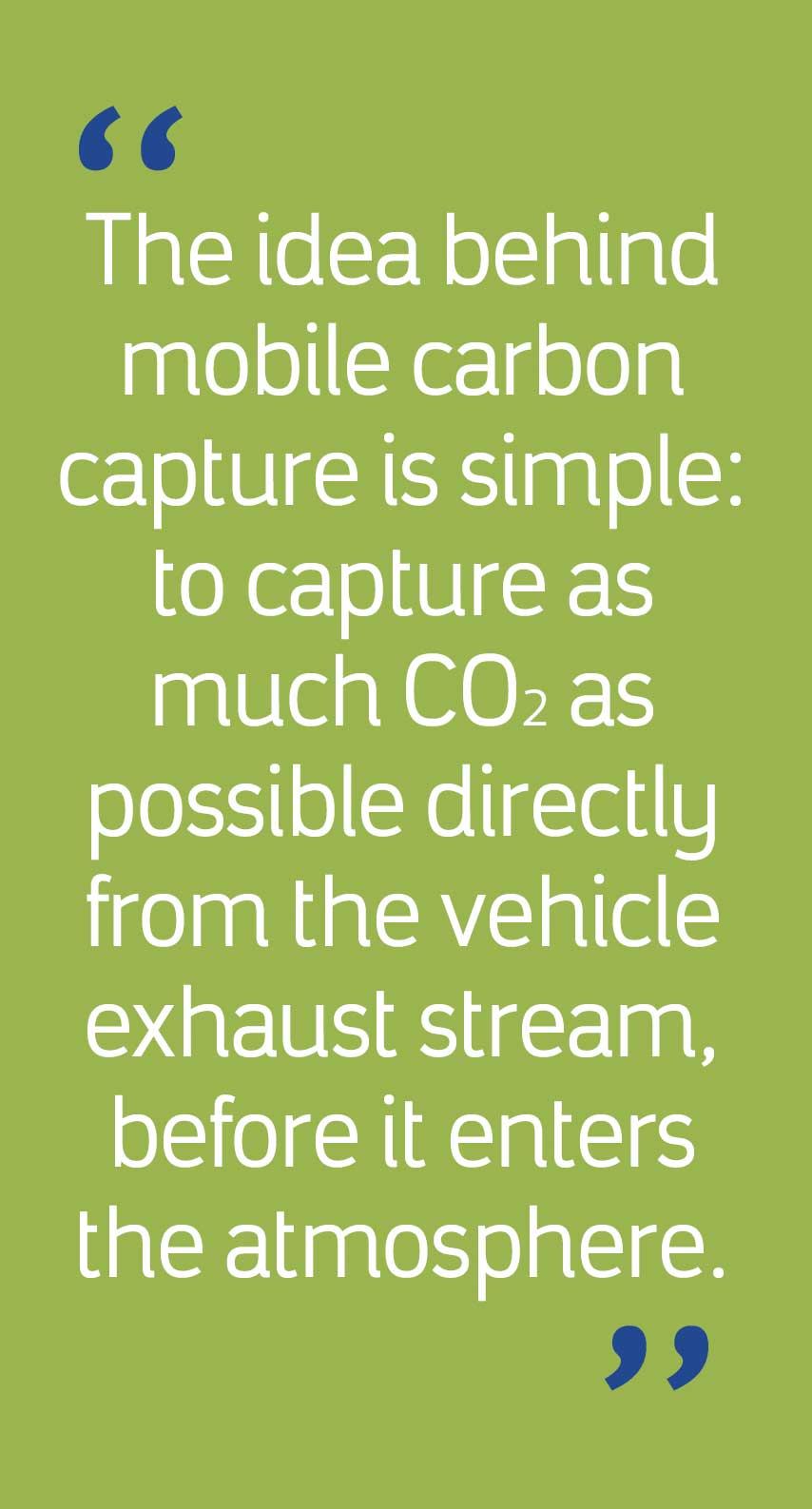Taking carbon capture on the road
Engineering Excellence.

- In 2010, a group of researchers at Aramco came up with an innovative idea: mobile carbon capture
- After a year of development, the team successfully integrated its carbon capture system into a Ford F-250 pickup truck
- Aramco conducts early stage R&D on mobile carbon capture for heavy-duty trucks and marine ships
Heavy-duty road, aviation and marine transport account for a large amount of CO2 emissions globally, with options to decarbonize these sectors still only in the early demonstration stages of development. The large energy requirements of these sectors add complexity to the challenge of decarbonization.
At Aramco’s research and development centers, researchers and scientists work diligently to find more sustainable solutions to some of today’s most pressing challenges. Sometimes, the most promising, innovative ideas are also the simplest in concept.
Mobile carbon capture is one such innovation.

Unravelling the riddle
The idea behind mobile carbon capture is simple: to capture as much CO2 as possible directly from the vehicle exhaust stream, before it enters the atmosphere. If applied and managed correctly, such an approach can lead to reductions in carbon emissions and become an appealing solution for the hard-to-abate heavy-duty road and marine transport sectors.
A brilliant thought. But can it be done?
Research scientists at Aramco have been working to answer this question for some time.

"The idea behind mobile carbon capture is simple: to capture as much CO2 as possible directly from the vehicle exhaust stream, before it enters the atmosphere."
The idea for mobile carbon capture first came to Dr. Esam Hamad, a Senior Research Science Consultant at Aramco, just over a decade ago. Shortly after, he submitted a rough sketch of his mobile carbon capture concept to his manager.
“I think he liked the idea,” says Esam. “He said: ‘Great. Can you do it in a year?’’’ With this goal in mind, Esam’s team began work in the lab. Developing the technology for heavy-duty road and marine engines is a challenge. The team started with proof of concept R&D activities involving light-duty vehicles.
Just one year later, in 2011, a prototype system was installed on a Ford F250 pickup truck, and the team was able to demonstrate for the first time the feasibility of capturing CO2 onboard a vehicle. Two years later, an improved capture system was developed and installed on a Toyota Camry passenger vehicle. The new engineering design enabled an improved capture rate, thus reducing the CO2 emitted from the tailpipe by 25%, when compared to a standard Toyota Camry.
So how does it work?

Mobile carbon capture explained
This innovative technology installs directly onto an automobile and uses a redesigned exhaust system to capture CO2 at the source: the gases that are produced after combustion.
The technology is powered by the heat that the engine produces during combustion, and is designed so that captured CO2 is stored onboard the vehicle and offloaded during refueling stops.
The first step in the mobile carbon capture process developed by Aramco is to expose the CO2 in the exhaust stream to a CO2 capture medium, such as a solution made from water and a basic nitrogen compound. Once the exhaust gas comes into contact with the medium, the CO2 naturally binds to it and is absorbed into the medium.
This isolates and removes some of the CO2 from the remaining exhaust gases. The exhaust, with reduced CO2, can then be released, while the captured CO2 is stripped from the capture medium, compressed and stored onboard the vehicle until it is offloaded at a fuel station.
So what could be done with captured CO2? Captured CO2 could be utilized in industrial operations or stored underground through sequestration. Industrial uses potentially include Enhanced Oil Recovery, making new materials and lower-carbon fuels, growing algae, or enhancing plant growth in greenhouses. Sequestration could enable storage of large quantities underground where local utilization is a challenge.

Future developments
For potential deployment of mobile carbon capture technology in road and marine sectors, several aspects for the technology and value chain require further development.
The first challenge is minimizing the size and mass of the system, so it has the smallest possible impact on the vehicle’s or ship’s carrying capacity. The research team, through its continuous technology optimization, has reduced the physical footprint of the technology and is working to make the system more compact.
Another challenge is to reduce the cost to make it economically feasible to market to owners and operators.
An important challenge towards deployment of mobile carbon capture technology is the ability to safely and sustainably offload CO2 after capture onboard a vehicle. This requires the creation of an entire new value chain. For potential marine applications in particular, the team has identified 27 port locations where nearby carbon capture utilization and sequestration (CCUS) infrastructure could be potentially utilized.

Rethinking CO2
When CO2 is captured, either by mobile carbon capture or through any other capture process employed in industry, the next step is to transport it to a storage site. This CO2 can be transferred via pipelines.
“In addition to just storing it underground, which is feasable, of course, another solution is to take the CO2 and convert it into useful products,” says Dr. Tamour Javed, a Transport Research Specialist at Aramco.
You could potentially use captured carbon by mixing it into concrete, through what’s called ‘carbonation curing.’ This process transforms CO2 from a gas into a mineral, and the resulting carbon matter, called carbonates, strengthens the building materials. The CO2 can also be transformed into a wide variety of useful materials, chemicals and fuels.
With the right product development and regulatory support, manufacturers around the world could begin to view CO2 as an attractive raw material.
Novel applications, new developments
Our early tests show that mobile carbon capture technology offers the potential to capture around half of the CO2 produced by internal combustion engines.
Our scientists are working with transport industry stakeholders globally on solutions to integrate mobile carbon capture technology, both on the road and on the seas. The technology has the potential to be feasible, at scale, across marine and land infrastructure.
Recently, the mobile carbon capture team began a new phase of development – integrating the technology into a class 8 heavy-duty truck. By combining mobile carbon capture with other efficiency-improving technologies, the team aims to lower the CO2 emissions of this class 8 truck by at least 50%.
Many players, one breakthrough
To progress beyond the experimental phase and enter production, every new technology needs a deployment plan.
For mobile carbon capture, Aramco's team of experts, from market analysts and chemical engineers to data scientists and logistical experts, are collaborating with the goal of translating the laboratory's success to reality outside the lab.
According to Dr. Tamour, although continuous scientific innovation and full value chain optimization is ongoing, the technology has the potential to be deployed in several commercial transport sectors. If implemented effectively, a significant number of vehicles on the road and ships at sea could operate with lower CO2 emissions.
In just over a decade, experts have transformed mobile carbon capture from a flickering idea into a potentially feasible solution for CO2 reduction in transport. And with more effort, this revolutionary new way to recycle may be coming soon to a highway near you.
Related Articles
The material in this article is intended to be for general informational purposes only, and readers should not place undue reliance on the statements or opinions therein. Any information provided speaks only as of the date this content was published and Saudi Aramco undertakes no obligation to correct, update, or revise any statements or opinions made in or implied by this article.



